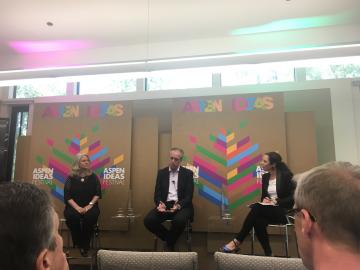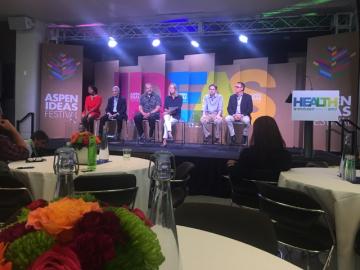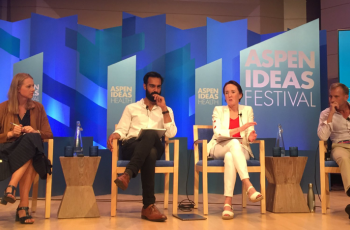Highlights from Spotlight Health 2017: The Future of Healthcare
We attended Spotlight Health 2017 in Aspen and took with us some incredible learning.
In This Article

Day One Learnings
We had a valuable first day at Spotlight Health, surrounded by frontline thinkers and innovators of health and medicine. At the opening reception, Walter Isaacson, president of The Aspen Institute, introduced 10 global health leaders who each shared a brave new idea they have about the future of health. It was so inspiring to hear the breadth and depth of ideas that have the potential to change the way that health is understood around the world.

The conference began yesterday afternoon, and we first heard Daniel Kraft and James Hamblin debate the question: Can Artificial Intelligence Revolutionize Medicine? This talk focused on how artificial intelligence (AI) will not replace providers, but instead augment, expedite, and improve access. They also discussed the potential of data and how it is being harnessed by IBM Watson, which uses AI to go through entire PubMed database, millions of patient records, and more.
We heard quite a few experts discuss the Senate bill that would replace the Affordable Care Act if passed. Judy Woodruff interviewed former Health and Human Services Secretary Kathleen Sebelius on the topic, and Sebelius was not shy when she said that the “Senate version [of the bill] may be less awful than the house version, but it’s still awful.” While she agrees that her version of Obamacare is not perfect (for example, it did not appeal to many young people), it has unequivocally reduced the number of people uninsured and increased patient safety. The Senate’s overhaul of the ACA will only leave more Americans uninsured and remove the safety net for those that need it most.

We also heard Stanford policy expert Lanhee Chen and key healthcare figure Andy Slavitt debate the Senate health care proposal released today. They shared, in their opinion, what works and what does not, and established some common ground despite their difference of opinions.
In a newly added Late Breaker session, “Health Reform Legislation to Arrive on Senate Floor,” we heard Julie Rovner, Joanne Kenen, Margot Sanger-Katz, and Elliot Gerson further discuss the release of the Senate healthcare bill. They shared all of the major changes and issues with the bill, using their knowledge and expertise in the health-centered media sector.
To end the night, we saw a screening of Bend the Arc, a film about the history of Partners in Health and the profound impact they’ve had on providing global care. Even after Paul Farmer, Jim Kim, and their colleagues consistently removed barriers to care for patients with TB (including multi-drug resistant TB) and HIV/AIDS in Haiti, Peru, and Rwanda, they received little support from the WHO and Congress. Time after time, they heard that their solutions were unsustainable, merely because global leaders were unwilling to pay the prices to get people the health care they deserved. With strategies such as employing community health workers and engaging in relentless advocacy, they have been able to build health systems from the ground up in over 10 countries that need it most. The film was followed by a discussion with key players Peter Drobac, Agnes Binagwaho, Cori Shepherd Stern, and Dan Glickman.
What an engaging and inspiring round of sessions we were lucky to attend! We look forward to seeing what the rest of Spotlight Health has in store for us.
Expert (and broad!) Thinking on Healthcare: Some Deep Dives
What a whirlwind of knowledge Spotlight Health has been. We feel fortunate, over the past three days, to have heard leading clinicians, policymakers, economists, academics, and innovators discuss the most pressing issues facing our healthcare system. After our first day at the conference (which you can read about here), we dove into two full days of sessions about caretaking, the social determinants of health, drug pricing, patient advocacy, and the future of type 1 diabetes. Here are some descriptions and takeaways from these areas – we’ll be back with our next set of learnings next week, including those from the Aspen Health Innovators:
1. A question asked throughout the conference was how we can improve the quality of care and ensure that care is delivered to those who need it?
- In “The Unseen Caring Economy,” Sheila Marcelo, founder and president of Care.com, said that women in the workplace have been a top driver of economic growth. When women leave the workforce to care for children or the elderly, the economy suffers. Therefore, we need technology to serve as a platform that connects caregivers with patients, allowing patients to get the care they need without compromising their family members’ jobs.
- In “Managing the Maze of Elder Care,” Alicia George, president of AARP, and Sarita Gupta, Co-Founder and Co-Director of Caring Across Generations, gave us two viable options for improving care for the elderly. The first is community living, which allows the elderly to age at home while surrounded with necessary resources. Multi-generational environments sound terrific from our view and we wonder what incentives there will be to make them as attractive as possible to all generations. The second is specific innovations that make care more accessible and allow the elderly to maintain their independence for as long as possible. An example of such a technology is the Amazon Echo, which uses “Alexa” to notify caregivers when an elder needs assistance.
-
In “Breaking the Cycle: Health, Poverty, and the Social Determinants of Health,” a striking statistic was introduced: people who live in different districts within the same city (Boston, in this case) can have life expectancies that differ upwards of 30 years. Such disparities are driven by the social determinants of health. Dr. Garth Graham, President of Aetna and professor at the University of Connecticut School of Medicine, further defined the addressable determinants of health, such as access to education and safe housing, which have the ability to improve health outcomes. Kevin Washington, president of the YMCA, talked about successful health innovations established by the YMCA, such as the Diabetes Prevention Program, which brings together people with prediabetes and encourages them to live healthier lives through diet and exercise. The YMCA has been successful because it has local stakeholders and community trust, while also harnessing their national recognition to scale their programs. We need more widespread programs with partners on the ground to help limit the progression of prediabetes to diabetes.

2. We then shifted gears and heard a discussion entitled “What Drives Drug Pricing?” The panelists were Dr. Aaron Kesselheim, medical professor at Harvard, Anula Jayasuriya, managing director and founder of EXXclaim Capital, Dr. Gregory Glover, principal of Pharmaceutical Law Group, and Steve Clemons, editor in chief of Atlantic Live. Here are a few of the points from this incisive session:
- Americans often face extremely high drug prices, which can lead to severe financial stress for those patients as well as lower adherence to the drug. The blame for these high costs is most commonly attributed to the pharmaceutical industry; however, pharmacy benefit managers and insurance companies play a key role in determining prices.
- The average American pays $1,000 more per capita for prescription medications than patients in any other developed country, even though the U.S. has one of the worst health care systems as measured by aggregate outcomes. In addition, profit margins for pharmaceutical companies average 21%, while those margins for the average Fortune 500 Company are at only 7%.
- Not surprisingly, many other countries have healthcare assessment organizations affiliated with the government that evaluate drugs, assess their efficacy, and decide their price. We hope that, in the future, the price of drugs will allow all patients to access the medicine they need.

3. Brain cancer patient and advocate Dr. Steven Keating highlighted the importance of patient autonomy in all fields of medicine during his session, “Can Sharing a Medical 'Selfie' Save Lives?” As a young research participant, Keating asked for an MRI of his brain and later used this information as part of a self-driven search to find his own brain tumor. He shared his journey to accessing his medical information and starting a movement to provide open-sourced medical data. Keating’s remarkable story has implications for many patients who should be able to access their medical information, be their own advocates, and make informed decisions with the use of new applications. Keating taught us that when patients understand the intricacies of their condition, they are more engaged and more likely to adhere to their treatment plans – this certainly applies to people with diabetes!
4. We continued to discuss patient advocacy in “Power to the Patient!” – one of our very favorite sessions overall at Spotlight Health – with Dr. David Blumenthal, CEO of the Commonwealth Fund, Dr. Robert Wachter, professor and chairman of medicine at UCSF, Lisa Suennen, managing director of GE Ventures, and Dr. Dave Chokshi, chief population health officer of NYC Health and Hospitals Corporation.
- The panelists discussed the patient-centric healthcare system needed to identify and adapt to specific patient needs. They also spoke about telemedicine, technology, homogeneity of markets, medical costs, and government intervention, all of which are factors in creating this patient-first system. Among these, Ms. Suennen emphasized that telemedicine was the single biggest success story in her view to date for digital health. It is positive for the healthcare system in terms of making things easier for patients and providers (when the health issues can be addressed remotely) and, much like the Amazon model, is convenient. Telehealth can be especially useful in rural areas with limited specialists, she said. However, she emphasized that technology is not the panacea.
- Panelists emphasized that artificial intelligence and computerized products lack an essential attribute for patients: trust. Patient-provider trust is what grounds healthcare and will bring us closer to a patient-centric model. However, to develop this, the patient must also have independence – blood glucose monitoring came up twice during the session as examples where patients are independently managing health, and Dr. Chokshi emphasized the points that patients can do this much more easily with better tools. Knowing their blood sugar level on a minute-to-minute basis matters for some patients and getting the right tools to the right patients is clearly critical – not only can the physician not do this.
5. Last, we attended an important session on type 1 diabetes, titled “Finding a Cure: A World without Type 1 Diabetes.” JDRF’s Margery Perry and City of Hope’s Bart Roep discussed their personal commitment to this matter. Perry’s son has type 1 diabetes, and Roep was inspired to study the science of diabetes in medical school after realizing that there was no understanding of the underlying cause of the disease. He says that, although he does not have T1D, he “lives it” through his work.
-
Perry and Roep discussed common misconceptions about type 1 diabetes. One is that only children are diagnosed with it when in reality, the majority of diagnoses happen in people over 30. While recognizing the importance of insulin as a life-

saving drug, they also described it as only palliative care. It is necessary to determine the root cause of the disease. Roep discussed the generous gift from the Wanek Family that will allow City of Hope to search for a cure for T1D (read about it here). They acknowledged that finding a cure is an ambitious goal, but described promising clinical trials, such as “big hammer” interventions in Brazil that have allowed patients with T1D to stay off insulin for sustained periods of time. - Perry described the problem of implementation and accessibility of diabetes technology. Although there have been great innovations for patients with T1D, many of those products have very low rates of acceptance, even in the United States. Perry said, “It is also important to have a global perspective on what constitutes a cure,” because “cure” means different things to people depending on their stage of the disease. “Cure” is also a subjective and loaded word, and people in the field have gotten their hopes up in the past when promised it. She suggested three tangible ways that the audience could get involved in participation and advocacy for T1D research: funding advocacy groups, taking part in clinical trials, and lobbying the government to support diabetes research.
What a tremendous gathering in driving food for thought on our massive health problems in the US and beyond – social, economic, physical. Indeed, throughout the conference, we heard leaders in the field define a wide range of serious problems in healthcare that must be addressed and we hope that they were heard by so many various leaders and philanthropists here (many are obviously already involved and changing the world!). However, few clear solutions emerged as that’s not the focus of this gathering – that is up to everyone here! Jeffrey Sachs, economist and professor of sustainable development at Columbia University, emphasized that, contrary to popular belief, we are not stuck in a rut. Instead, we live in a rapidly changing world, and we must learn to “ride the wave” in his words. In order to move forward and address (much less solve) such issues, our nation must plan ahead to create a world based on honest and thorough analysis and think critically about the morals we hold to be true.
Wrapping Up in Aspen: Neuroscience, Opioids, and the Future of Healthcare
We are excited to update you on the rest of our top sessions from Spotlight Health. We learned so much about neuroscience (in regards to health outcomes), the opioid epidemic, and the changing landscape of healthcare. We were also lucky to hear a few star speakers, from all sides of the aisle, at the Spotlight Health closing ceremony.
1. Our brains are complicated and fascinating, and we do not understand exactly how they work. Yet by hearing from some of the leading experts in neuroscience, we can better understand how our upbringing, through education, socioeconomic status, and place of birth, influence our brains and related health outcomes.
- In The Neuroscience of Poverty, Martha Farah, a neuroscientist at the University of Pennsylvania, found that the development of the hippocampus and prefrontal cortex is determined by peoples’ location of upbringing, as people living in difficult, poverty-stricken locations tend to have underdeveloped hippocampi and prefrontal cortices. However, David Leonhard, op-ed columnist at The New York Times, said that there is a linear effect on time of movement; there is no one critical age after which brain function declines depending on location. While it is better for children to move out of undesirable neighborhoods earlier in life, there is no time in which a child is a lost cause. Angel Kyodo Williams, founder and senior fellow at the Center for Transformative Change, said, “Neuroscience can help us understand that kids raised in poverty are not bad kids.” There are some behavioral practices that can help people in difficult circumstances thrive. For example, strong, loving relationships and meditation/mindfulness are able to buffer the effects of poverty on development.
- In Applying Neuroscience to the Classroom, we learned about the ways that adverse childhood experiences (ACEs) severely affect how children learn. Nadine Burke-Harris, founder and CEO of Center for Youth Wellness, said that there are immunological consequences of ACEs that keep children out of the classroom. There are also neural consequences of ACEs that disrupt learning when children are in the classroom. Sarah Watamura, associate professor of psychology at the University of Denver, talked about protective factors for children who experience ACEs, most importantly through healthy relationships and the support of adults. Burke-Harris agreed, saying, “Safe, stable, nurturing relationships are the antidote to toxic stress.” In both talks, we heard that healthy relationships are crucial in development, especially for children who face difficult environments.
2. In The Opioid Tsunami, Surgeon General Vivek Murthy, among others, discussed the tragic toll of the opioid epidemic, largely on underserved white communities. Murthy discussed the Turning the Tide Campaign, an intervention he created about the opioid epidemic by sending a letter to 2.3 million healthcare providers. He urged clinicians to take responsibility for their patients who are addicted to opioids because, no matter how well-intentioned physicians are, they may have contributed to the epidemic through over-prescribing certain medications. He did not blame physicians but instead wrote about the opportunity they have to redefine addiction as a chronic disease of the brain. Physicians can, and have the responsibility to, change how they prescribe opioids, get people the treatment they need, and educate the public about addiction as a chronic illness.
3. Of the many programs offered by the Aspen Institute, the Health Innovator Fellowship is unique in its support for those who are changing the healthcare landscape in the United States. As part of the “Visionary Leaders: The Aspen Institute Health Innovators Fellowship” session, we were fortunate to hear some of the fellows speak.
- We heard Shannon Jaccard, CEO of NAMI San Diego, speak about the stigmatization of mental health. People with mental illness die on average 25-years earlier than people without mental illness, and the leading cause of death among this group is suicide. Although social movements and other interventions have decreased the stigma around mental health, the U.S. mental health system has failed us. When mentally ill patients seek help, they are frequently handcuffed, put in the back of a police car, brought to a small, bare room in the hospital, and tied down. Once this negative impression of the hospital is implanted in patients, they will seldom go voluntarily. We need hospitals to be seen as tools for care. Considering that 1 in 5 people in the U.S. have a mental illness and 1 in 4 caregivers provide for someone with one, we must end the stigma on mental health and care for patients in safe institutions where they feel comfortable enough to heal.
- We also had the opportunity to hear Rebecca Onie, CEO of Health Leads, speak about the environmental factors of health – food, housing, transportation, and beyond. Seventy percent of health outcomes depend on environmental factors outside of the hospital, yet we do not address this large component of population health. Onie argued that we should maintain a registry of food insecure patients, just like the one we have for heart disease. You can provide patients with excellent care in facilities, but once they return to the same environment, they can relapse and the care may be rendered useless. Strikingly, there are on average only about 2 social workers per 24,000 pediatric patients – and doctors don’t learn about housing or food pantries in medical school. Healthcare providers must take environmental factors more seriously and prescribe solutions beyond pharmaceutical drugs – fruits and vegetables, adequate exercise, local community housing, etc. – in order to achieve true health outcomes.
4. At the Spotlight Health Closing Ceremony, we had the honor of hearing the diverse perspectives of three key leaders: Tom Price, U.S. Secretary of Health and Human Services; Larry Brilliant, one of the leaders of the World Health Organization’s smallpox eradication project; and Cecile Richards, President of Planned Parenthood.
- Tom Price talked about the repeal of the Affordable Care Act (ACA) and the desired implementation of the new American Health Care Reform bill. He lamented that certain small businesses cannot expand due to restraints set by the ACA, which specifies that businesses with over 50 employees must offer health benefits. Price also questioned the efficacy of the ACA, claiming that there are still 28 million uninsured Americans and that medical bankruptcy is a uniquely American phenomenon. We want a system that incentivizes innovation, empowers patients, and promotes accessibility, quality, and affordability – and Price believes the recently introduced Senate bill is on track to do this. However, his praise of the bill was not shared by most of the audience, who are understandably terrified by the projections that the bill will leave 22 million more Americans uninsured.
-
Larry Brilliant took a bipartisan approach, discussing how we have evolved into such a harsh and acrimonious country, especially when debating healthcare. He criticized the clandestine development of the new healthcare bill and how our political system no longer represents the views and needs of American patients. Brilliant denounced the deliberate use of divisiveness as a political tool and called for a more bilateral, unified approach to healthcare reform.

- Cecile Richards used her platform to represent the left and uphold the ACA. Planned Parenthood, a lightning rod among conservatives, is at risk of losing funds for prevention services under the proposed Senate bill (Planned Parenthood was never given government funds for abortion in the first place). Richards pointed out the severe impact this bill would have on the millions of people who go to Planned Parenthood each year for cancer screenings, STI tests, contraceptive access and education, abortion services, and beyond. Richards highlighted the integral role of women in the economy and the consequences that ensue when women do not have the right to birth control and contraceptives, giving others the right to decide if and when they will have children.
After an amazing four days, we are sad to see Spotlight Health come to a close. We have shared our most important insights with you, but click here to watch more videos from the leaders in the field. We learned so much about healthcare—the biggest challenges, successes, and ideas for the future. We look forward to following these leaders as they continue to think critically and innovate for our future.
